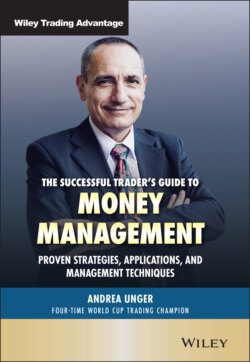Читать книгу The Successful Trader's Guide to Money Management - Andrea Unger - Страница 10
Foreword
ОглавлениеThe second millennium began with the explosion of online trading in Europe, as the increase in the amount of available information and advertising of various kinds goes to show, encouraging many to try their luck at trading on the financial markets.
A considerable number of brokers set up shop and offered their services both for trading online and speculation on the markets, and new books are published almost every day, written by expert traders giving a great deal of advice on how to win on the markets. There are dozens of books on scalping, more on speculation in general, and even more on trading systems, not to mention those on technical analysis and even a few on trading psychology. An expert trader following the continuous evolution of these publications can't help but notice that (in Europe) one thing that's missing is a book that explains a subject that's by far the most important for he or she who wants to make trading their profession, in other words: money management (hereinafter referred to simply as M.m.).
In this book the author explains all the important points of how to manage your own capital in detail in consideration of the risk and the far‐from‐remote possibility that you might lose everything before you've even learnt how to place consistently winning trades on the market.
The author has explained the subject in a clear and frank way, making the book suitable for beginners and expert traders alike, and with the obstinacy of someone who's learned their lessons firsthand in the field he repeatedly emphasizes the importance of applying the right money management techniques. It would be a shame not to make the most of all the secrets this book has to offer.
The author's desire to help the reader understand that money management isn't the same as using a stop‐loss can be found in every chapter. Also, the various methods discussed throughout the book, which are intrinsic to the strategies that can be applied to manage assets, let the trader prepare a plan of action for their M.m. that's as close as possible to perfect.
Anyone who reads this book will realise that technical analysis, trading systems, and various methods – no matter how valid they may be – are all but worthless without the effective management of your assets, and it would be a real shame if the reader failed to make the effort to apply some of the numerous suggestions they could make on their own after reading the book. The author, however, advises against using a poor strategy with the meticulous application of M.m. even if that can produce acceptable results, and this should perhaps make us reflect on the fact that the correct application of M.m., as well as protecting yourself from the risk of going bankrupt, can also help you obtain spectacular results that would be impossible without correct money management.
I love reading books on trading (I don't think many people have a collection as vast as mine on the subject), and I can truly say this book on money management is a must, and is the first complete and clear book to come out of Italy on how to apply M.m. to financial markets. I was lucky enough to be given the chance to read it first, and made good use of numerous suggestions to manage some futures' trading strategies, so I must compliment the author on the excellent work he's done in creating a book that's a real one of a kind – a book readers would do well to read and read again, always keeping it on hand to use as a point of reference to dispel any doubts on the correct way to manage the method they're adopting.
Domenico Foti
